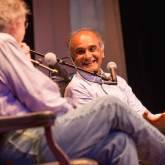
A few of my favorite poets & poems: Billy Collins’ Aimless Love, Mark Strand’s Black Sea, Dora Malech’s To The You Of Ten Years Ago, Now, The Complete Poems of Elizabeth Bishop, Selected Poetry of Edna St. Vincent Millay, How To Eat A Poem, & Jennifer Chapis’ Rain At The Beach.
When I was a middle school Humanities teacher in New York City, poetry was my favorite unit to teach. I loved it mostly because of how much my students loved it. All of a sudden, my most problematic and reluctant students were letting their guards down and opening up to creativity and self-expression. I made it fun for them. I acknowledged that they didn’t have to understand every word or what the poet was trying to say, but just to enjoy the way the words were organized on the page. I pointed out that poems were short, so it didn’t take very long to read them. We read each poem four times because there was always something new to discover.
They wrote emulation poems of William Carlos Williams’ This Is Just To Say and Pat Mora’s bilingual poem The Desert Is My Mother and cinquains and free verse and whatever they wanted to write. We read Langston Hughes, Emily Dickinson, Shel Silverstein, Edgar Allan Poe, Gary Soto, Robert Frost. The tough boys in my class were now writing poems about baseball and football and relating these themes to their families and their dreams. We were reading poetry, writing poetry and reading each other’s poetry. In my planning periods, I’d find myself surfing Poets.org clicking from one poem to the next and relishing in them.
During April’s National Poetry Month, The Academy of American Poets¬†(who run Poets.org) provided educators with a free poetry anthology How To Eat A Poem: A Smorgasbord of Tasty and Delicious Poems for Young Readers (I still have my copy today). After the Foreward, there’s a few lines from Marianne Moore’s¬†Poetry:
I, too, dislike it.
Reading it, however, with a perfect contempt for it, one discovers in
it, after all, a place for the genuine.
I’d write that quote on the board on the first day of the unit and it immediately disarmed my students. I remember being turned off by a lot of fiction and poetry in high school English class when it was applied too heavy-handedly by my teachers. (Wallace Stevens’¬†The Emperor of Ice Cream, for instance, still sticks in my mind as a poem I didn’t much care for).¬†And I didn’t want to do that to my students. I told them upfront that they didn’t have to like every poem that we read, but they had to at least consider it.
It was around that time that Poets.org started their “Poem A Day” emails. My dad and I both signed up and to this day we forward each other poems with our thoughts, criticisms and inside jokes. Moving to Key West continued to deepen my love for poetry, an island so apt for the art form. I discovered Elizabeth Bishop who spent time in Key West and I devoured The Complete Poems: 1927-1979, loving how much¬†Pleasure Seas perfectly described the natural beauty of the island I lived on and swooning every time I read¬†One Art.
I began working on the event staff for the Key West Literary Seminar and one year the theme was poetry, specifically¬†Clearing the Sill of the World: a Celebration of 60 Years of American Poetry in honor of Richard Wilbur. And Richard Wilbur was there (because he once lived in Key West) whose poem¬†The Writer I love, and so was Rita Dove, Mark Strand, Robert Pinsky, James Tate, Jane Hirshfield and my friend Billy Collins–all of these Poet Laureates and award-winning poets, and they were not stuffy and formal and boring, as one might expect poets to be. They were funny and brilliant.
I am so pleased that poetry has been infused into my daily life for so many years now. Whether it’s clipping out a poem from¬†The New Yorker that particularly resonates with me or forwarding a poem to my dad for his commentary, it’s a treat to have a time out in the day to ponder and enjoy the pleasure of a few lines of poetry.
I’ve also loved discovering new voices like Ada Limon, Sommer Browning and others who I follow on Twitter now. The kernels of great lines of poetry stay in my head and I recall them at different moments. I recite some version of these last few lines of Limon’s¬†Roadside Attractions with the Dogs of America¬†to my dog Rascal on a near-daily basis.
They want to be your only dog,
your best-loved dog, for this good dog of today
to be the only beast that matters.
Another poem that’s stayed in my head as a sort of coda is Edna St. Vincent Millay’s¬†Travel.
I remember being in Key West on the back of a parasail boat while my captain zoomed out to sea, and I’d look up in the sky and see an airplane, and think of the last stanza of Millay’s poem substituting train for plane.
Another travel poem I find particularly captivating is Elizabeth Bishop’s¬†Questions of Travel,¬†which takes a rather derisive tone¬†¬†towards that longing to travel, pitting it in existential limbo (which I think every frequent traveler or nomad finds themselves in from time to time). She asks:
What childishness is it that while there’s a breath of life
in our bodies, we are determined to rush
to see the sun the other way around?
and
Should we have stayed at home,
wherever that may be?
There’s something about poetry that gets to the heart of thoughts, feelings and emotion with far more precision and nuance than prose can. In honor of April’s National Poetry Month and Poem in Your Pocket day (which is today!), these are just a few of my favorite poems and an explanation of why I love poetry so much. I’d love to know what poems you love and why. Please share in the comments below!
Also, if you want a taste of more poetry, I highly recommend you checkout Poets.org and sign up for their Poem A Day email. As I’d say to my students, if you don’t think you’ll read them every day, that’s okay (you can always delete them). A new one will pop into your inbox at a moment when you can.








